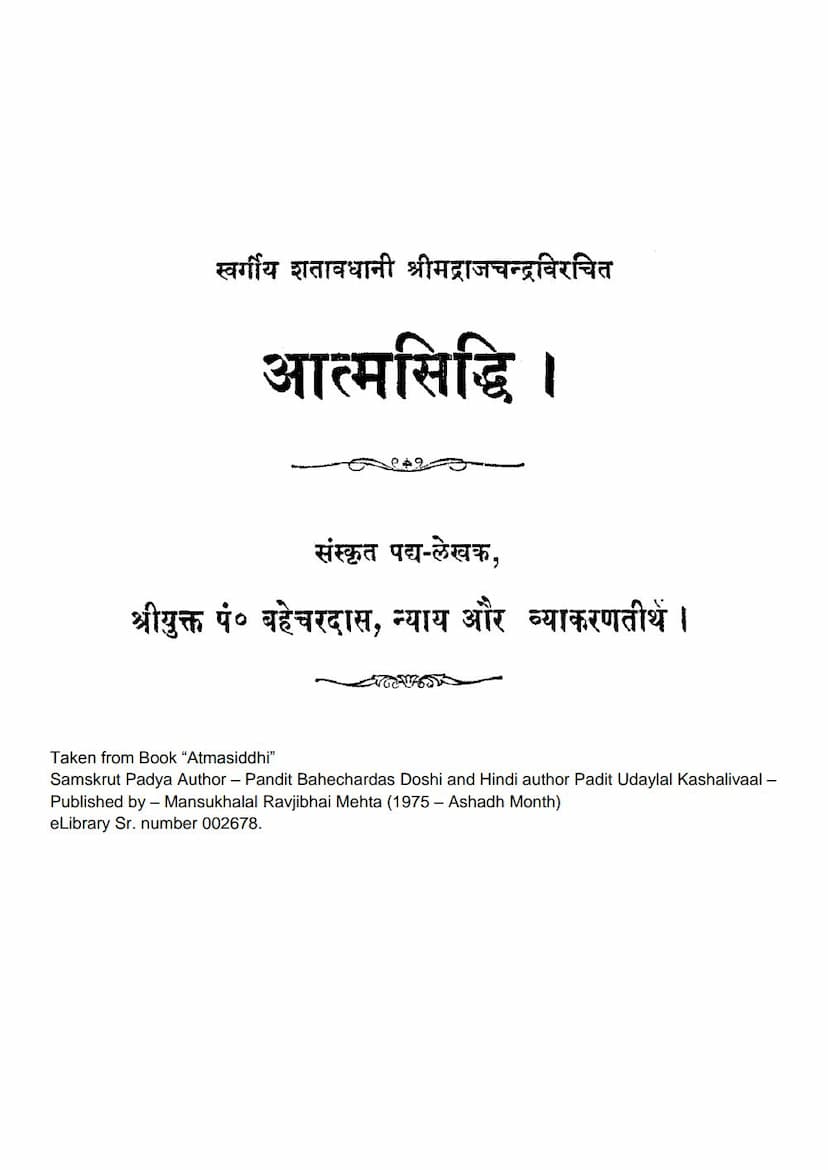Aatmsiddhi Shastra In Sanskrit
Added to library: September 1, 2025

Summary
Here's a comprehensive summary of the Jain text "Aatmsiddhi Shastra" in Sanskrit, based on the provided pages:
The book "Aatmsiddhi Shastra" is a Sanskrit rendering of the teachings of Shrimad Rajchandra, with Pandit Bechardas Doshi as the Sanskrit poet. It's published by Mansukhlal Mehta, Mumbai.
The text, starting with an invocation to the Sadguru (true spiritual teacher), addresses the spiritual seeker (Atmarcharana) in the current era of Kali Yuga, where the path to liberation (Moksha Marga) is often obscured. The author expresses compassion for those who are either "action-bound" (kriyajada), overly attached to external rituals without true understanding, or "knowledge-bound" (gyanajada), who merely speak about liberation without genuine realization or practice.
The core of the Aatmsiddhi Shastra revolves around the nature of the soul (Atma) and the path to liberation. It emphasizes the critical role of a Sadguru, highlighting that true spiritual progress is achieved through their guidance. The text differentiates between the "Atmarchari" (one who strives for self-realization) and the "Matarthi" (one who is attached to sectarian views or opinions).
Key Themes and Teachings:
- The Sadguru's Importance: The text repeatedly stresses that a Sadguru is essential for understanding the true nature of the soul and achieving liberation. They are described as knowledgeable, equanimous, and one who has transcended the cycle of birth and death. The guidance of a Sadguru is considered more potent than any indirect help.
- Distinguishing the Atmarchari and Matarthi:
- Atmarchari: One who seeks the Self, adheres to the teachings of the Sadguru, relinquishes personal biases and opinions, strives for detachment from worldly desires, and possesses virtues like compassion, equanimity, and truthfulness. They are characterized by inner peace and a genuine desire for spiritual liberation.
- Matarthi: One who is attached to external rituals, mere textual knowledge without inner realization, worldly honors, sectarian doctrines, and holds rigid views. They often lack inner detachment and true spiritual understanding.
- The Nature of the Soul (Atma): The text delves into discussions about the soul's existence, permanence, and nature. It counters the views that the soul is merely the body, breath, or senses. The soul is described as eternal, unchanging in its essential nature (though its modes may change), the perceiver of experience, and distinct from the physical body and its modifications. The author uses analogies to illustrate this distinction.
- The Path to Liberation (Moksha Marga):
- Renunciation and Detachment: True renunciation (tyaga) is linked to self-knowledge. Those who are solely attached to external renunciations without inner detachment are considered misguided.
- Right Faith (Samyaktva): This is attained by relinquishing sectarian views and dogmatism, and by sincerely following the path shown by the Sadguru. It involves recognizing the true nature of the soul.
- Right Conduct (Charitra): This is characterized by detachment from passions and the realization of the soul's inherent state.
- Knowledge (Jnana): True knowledge leads to the destruction of delusion (moha) and leads to liberation.
- The Role of Karma: The text discusses how karma binds the soul. The ultimate cessation of karma is achieved through right knowledge and conduct, leading to liberation. It questions the concept of an external Ishvara (God) as the doer or dispenser of karmic fruits, emphasizing the soul's inherent nature and its interaction with karma.
- Addressing Doubts and Misconceptions: The verses address common philosophical questions and doubts regarding the soul's existence, its relation to karma, and the path to liberation. The author refutes nihilistic or materialistic views that deny the soul or its eternal nature.
- Inner Purity and Control of Passions: The cessation of passions like anger, pride, deceit, and greed (kashayas) is highlighted as crucial for spiritual progress. Inner peace and equanimity are emphasized.
- The Ultimate Goal: Liberation (Nirvana) is described as the state of pure, untainted consciousness, free from the cycle of birth and death, and characterized by infinite bliss and knowledge.
The text concludes with the student (Shishya) understanding the teachings and the guru (Bhagavan) entering into a state of silent contemplation, signifying the profoundness of the realization. The teachings are presented as a direct path to self-discovery, leading to the ultimate freedom and inherent bliss of the soul. The author also expresses deep gratitude to the Sadguru for revealing this path.